|
|
|
Sort Order |
|
|
|
Items / Page
|
|
|
|
|
|
|
| Srl | Item |
| 1 |
ID:
170886
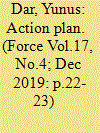

|
|
|
| 2 |
ID:
132358


|
|
|
|
|
| Publication |
2014.
|
| Summary/Abstract |
How and to what extent is the preventive use of force becoming the future of foreign policy for states around the world? We explore the spread of preventive logic to increasing numbers of states and examine the degree to which an international norm toward preventive self-defense is cascading in the international system. Through content and comparative case study analysis, we investigate leaders' rhetoric and security policies concerning what we theorize is the key indicator of a country's emulation of the United States: assertion of the right to the unilateral, preventive use of force outside of its borders. Our evidence indicates that there has been a shift away from the established international norm-which considers the use of preventive force illegal and illegitimate-toward growing acceptance of unilateral preventive strategies, a shift largely propelled by the precedents set by the United States in the war in Iraq and its use of unmanned aerial vehicles (UAVs or drones) in the global war on terror. Our findings also reveal that some states are applying the strategy of preventive self-defense beyond the use of UAVs for targeted killings to the extreme contingency plan for nuclear war. We conclude by discussing possibilities for further research and considering the implications of this phenomenon.
|
|
|
|
|
|
|
|
|
|
|
|
|
|
|
|
| 3 |
ID:
172569


|
|
|
|
|
| Summary/Abstract |
Current dynamics in UCAV proliferation in the Middle East signal that combat drones have become key strategic enablers for state actors in the region, and are no longer seen as an optional asset. With the development of a multitude of indigenous UCAV projects, and the arrival of Chinese-made armed drones on the international market, military procurement in the Middle East has entered a new phase, in which possessing armed drone capabilities is becoming the norm. This article examines the operational and strategic considerations driving Middle Eastern states’ UCAV procurement policies, analysing those countries who have been focusing on armed drones for combat purposes and additional intelligence, surveillance, target acquisition, and reconnaissance (ISTAR) needs. The main drivers behind this trend are the operational and strategic advantages brought about by UCAVs, where the benefits related to cost, reliability, and operational risk mitigation are matched by the increased ability to project power that the platform allows, either through deniability or by making UCAVs available to proxies and allies.
|
|
|
|
|
|
|
|
|
|
|
|
|
|
|
|
| 4 |
ID:
097132
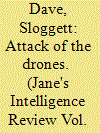

|
|
|
| 5 |
ID:
160087
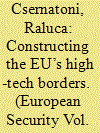

|
|
|
|
|
| Summary/Abstract |
FRONTEX has highlighted Remotely Piloted Aircraft Systems (RPAS) as affordable and efficient capabilities for securing the EU’s vast frontiers in order to further upgrade them into smart technological borders. In this regard, this article examines the EU’s strategy and rationalisations to develop dual-use technologies such as aerial surveillance drones for border management. By drawing on critical security and technology studies and by focusing on their functional technological efficiency, the article argues that drones are being normalised in a technological regime of exclusion at the border-zone. It further contends that high-end technologies such as drones introduce a military bias as security enablers in border surveillance and as a panacea for the consequences of failed policies to manage irregular migration. A closer examination of several EU-endorsed drone projects reveals a pragmatic and industry-driven approach to border security, underlining the evolving homogenisation between internal and external security and the imminent “dronisation” of European borders.
|
|
|
|
|
|
|
|
|
|
|
|
|
|
|
|
| 6 |
ID:
189994
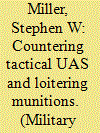

|
|
|
| 7 |
ID:
139094


|
|
|
|
|
| Summary/Abstract |
This article examines the term ‘assassination’ as describing a certain kind of killing which may – and does – occur in warfare. It critiques current definitions of the term to synthesise a stronger and more value-neutral definition: the premeditated killing of a specific individual in order to realise political objectives. It also critiques the term ‘targeted killing’ for a comparative lack of analytical clarity. The article then presents a theory of the goals assassination may achieve and the effects it may have on a conflict environment, when occurring within a military context. The article reviews three case studies which illustrate the scope of the theory, and concludes by noting that assassination can be the subject of legitimate ethical debate, as it may potentially adhere to the norms of Just War Theory, while constituting a valid category of military action.
|
|
|
|
|
|
|
|
|
|
|
|
|
|
|
|
| 8 |
ID:
144729


|
|
|
|
|
| Summary/Abstract |
Australian defence strategy is disjointed and incomplete. Some would say that it is non-existent. Either way, this paper argues that Australia’s underwhelming approach to defence is the product of a crippling geographically focused strategic dichotomy, with the armed forces historically having been structured to venture afar as a small part of a large coalition force or, alternatively, to combat small regional threats across land, sea, and air. However, it is argued that Australia can no longer afford to drift between these two settings and must take measures to define a holistic “full spectrum defence” strategy and develop capability to fight effectively and independently across all domains of the twenty-first century-battlespace: land, sea, air, space, and the cyber realm.
|
|
|
|
|
|
|
|
|
|
|
|
|
|
|
|
| 9 |
ID:
181990
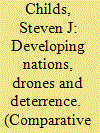

|
|
|
|
|
| Summary/Abstract |
Ensuring the survivability of second-strike nuclear forces is critical for strategic stability, yet some scholars contend that technological changes in surveillance by established nuclear powers are reducing their survivability in a new era of counterforce. What are the implications of the proliferation of unmanned aerial vehicles (UAVs) on deterrence between small nuclear powers (SNPs)? Would these systems allow SNPs to appreciably increase their confidence in counterforce targeting? This article examines developments in the India–Pakistan dyad to consider how the proliferation of UAVs to SNPs might alter the decision calculus regarding preemptive strikes.
|
|
|
|
|
|
|
|
|
|
|
|
|
|
|
|
| 10 |
ID:
102698
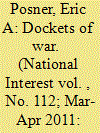

|
|
|
|
|
| Publication |
2011.
|
| Summary/Abstract |
SMART BOMBS cannot take out WikiLeaks. Stealth bombers cannot eliminate the bad odor wafting around Guantánamo Bay. Unmanned drones armed with Hellfire missiles cannot stop foreign countries and NGOs from putting America "on trial" for targeted killings. Lawfare is taking over international relations-or so many people believe. The most awesome military power in the world blunders about like a helpless giant in a dark room, swarmed by hostile forces that it cannot see and cannot attack.
|
|
|
|
|
|
|
|
|
|
|
|
|
|
|
|
| 11 |
ID:
168403
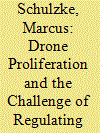

|
|
|
|
|
| Summary/Abstract |
The controversy surrounding military drones has generated many proposals for restricting or prohibiting existing drones, additional autonomous variants that may be created in the future, and the sale of drones to certain markets. Moreover, there is broad interest in regulating military drones, with proposals coming not only from academics but also from NGOs and policymakers. I argue that these proposals generally fail to consider the dual-use character of drones and that they therefore provide inadequate regulatory guidance. Drones are not confined to the military but rather spread across international and domestic security roles, humanitarian relief efforts, and dozens of civilian applications. Drones, their component technologies, the control infrastructure, and the relevant technical expertise would continue to develop under a military-focused regulatory regime as civilian technologies that have the potential to be militarized. I evaluate the prospects of drone regulation with the help of research on other dual-use technologies, while also showing what the study of drones can contribute to that literature. Drones’ ubiquity in nonmilitary roles presents special regulatory challenges beyond those associated with WMDs and missiles, which indicates that strict regulatory controls or international governance frameworks are unlikely to succeed. With this in mind, I further argue that future research should acknowledge that drone proliferation across military and civilian spheres is unavoidable and shift focus to considering how drone warfare may be moderated by countermeasures and institutional pressures.
|
|
|
|
|
|
|
|
|
|
|
|
|
|
|
|
| 12 |
ID:
151421


|
|
|
|
|
| Summary/Abstract |
This article analyzes the political utility of US drone strikes theoretically and deductively. Placing strikes within the context of the theorized political functions of force and considering how they fit into two grand strategies, restraint and selective engagement, I argue that these strikes buy the United States relatively little in the way of political effects assuring its own security because the terrorism threat they are intended to combat is a limited one within the skein of US global interests. Furthermore, their contribution to counter-terrorism efforts is likely to diminish with the adoption of armed drones by non-state actors. Drone strikes can, however, provide leverage over recalcitrant US client states while reassuring liberal partners and giving them some leverage over US choices. In addition, within the counter-terrorism sphere, drone strikes are less likely to inflame popular opinion than are alternative uses of force. This analysis contributes to an increasingly rigorous examination of the strikes’ role in US foreign and security policy.
|
|
|
|
|
|
|
|
|
|
|
|
|
|
|
|
| 13 |
ID:
160998
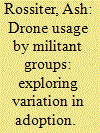

|
|
|
|
|
| Summary/Abstract |
Judging by recent media reporting and pronouncements by senior US military and security officials, the use of drones by militant groups is both reshaping conflict between armed non-state actors and state parties and now presents a grave and direct threat to nations in the West and elsewhere. But does this threat warrant the attention it is currently receiving? To answer this question, this article surveys how various militant groups have used drones both tactically on the battlefield and for wider strategic purposes. Closely examining how drones have been employed and by whom provides a basis for understanding variation in adoption. The article shows how drone usage or non-usage is highly contingent on the setting of the conflict, the aims of different groups, and the capacity of groups to adopt the technology. Though advances in drone technology could make the use-case more appealing for militant groups, drones will be subject to the same back-and-forth, techno-tactical adaptation dynamic between adversaries that have accompanied prior military innovations.
|
|
|
|
|
|
|
|
|
|
|
|
|
|
|
|
| 14 |
ID:
157626
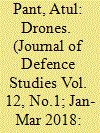

|
|
|
|
|
| Summary/Abstract |
From the days of their inception, remotely piloted aero models (known popularly as drones) have been feared as a means of spreading terror. Recently, the use of drones by terrorist outfits like the Islamic State of Iraq and Syria (ISIS), also known as the Islamic State (IS), has seen an increase and this has brought those fears to the fore. Experts fear that the drones have given terrorists a near-perfect solution for spreading terror and a major terror act may be around the corner as legal and illegal drone activities are on the rise. Many solutions have been put forth but none are foolproof, and the governments are looking for more reliable and acceptable solutions by seeking answers in technology. This article reflects on the extent of the problem and highlights the nuances of looking at such technology and its misuse. It deliberates on the current solutions available to counter the use of drones for terror activities and suggests some new and possible counters to the same.
|
|
|
|
|
|
|
|
|
|
|
|
|
|
|
|
| 15 |
ID:
138583


|
|
|
|
|
| Summary/Abstract |
High operational reliability is an essential prerequisite for UAVs. A good engine is the most difficult aspect in the designing of a UAV. Designers have to make sure that the engine can support the airframe and the UAV has a low signature through low vibration. It should be able to support long-endurance missions over the target. Another area of operational reliability for a UAV comes from its airframe, which should be able to support the mission in all types of conditions, especially rough weather. There is a flipside to the development of the drones globally. A recent report by the Rand Corporation warned that, in the future, terrorist groups might be able to buy small, armed drones, “Smaller systems could become the next IEDs – low-cost, low-tech weapons that are only of limited lethality individually but can cause considerable attrition when used in large numbers over time.”
|
|
|
|
|
|
|
|
|
|
|
|
|
|
|
|
| 16 |
ID:
123890
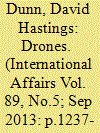

|
|
|
|
|
| Publication |
2013.
|
| Summary/Abstract |
The Obama administration's controversial use of drones in Afghanistan, Pakistan and Yemen has made the subject a hot topic of political and academic discourse. While most of this debate has focused so far on the legal, ethical and prudential use of large armed aerial vehicles, this article seeks to address the potential wider impact of this new technological innovation.
The article argues that drones constitute a new and disruptive technology not just in the way that they have been used to enable a new form of counterterrorism. Instead, it argues that drones pose a new form of terrorist threat against the West which is at present under-analysed, unarticulated and underestimated.
Part of the reason for this underestimation is the failure to appreciate the scale and scope of drone use for commercial purposes which is about to unfold. Technological innovation now means that drones will be capable of many jobs currently performed by small planes and helicopters, but more cheaply and easily - in addition to many other new applications.
The proliferation of this cheap and easily available technology will make its application for terrorist use easy to achieve and difficult to counter. The ability of drones to penetrate traditional defences and established conceptions of what constitutes a plausible threat is a challenge which so far has gone unheeded. This article seeks to challenge that complacency.
|
|
|
|
|
|
|
|
|
|
|
|
|
|
|
|
| 17 |
ID:
125948
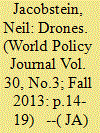

|
|
|
|
|
| Publication |
2013.
|
| Summary/Abstract |
Drones belong to a broad class of accelerating technologies that are increasing in capabilities as they decrease in cost. Driving this acceleration of technical capability is the exponential growth of information. Computer hardware and software, advanced aircraft materials, and imaging technologies such as high-resolution video cameras are all benefiting from lower costs and higher performance. For some applications, what used to take a $1 million drone can now be accomplished with a drone that costs less than $1,000.
|
|
|
|
|
|
|
|
|
|
|
|
|
|
|
|
| 18 |
ID:
122401
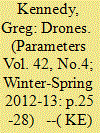

|
|
|
|
|
| Publication |
2012-13.
|
| Summary/Abstract |
The appearance of new weapons' technologies often gives rise
to questions of legitimacy. The use of missile weapons against
armored knights was considered illegitimate and unchivalrous by
some, as well as a destabilizing influence on the conduct of civilized
warfare. An acknowledged and accepted set of rules, designed to limit the
vulnerability of the ruling elite in combat, made longbow and crossbow
technology illegitimate in the eyes of that warrior-class.1
German U-boat
actions against commerce in World War I, the use of aerial bombardment against civilian populations, and defoliation agents in Vietnam, are
modern examples of new technologies whose legitimacy was contested
in times of conflict.2
|
|
|
|
|
|
|
|
|
|
|
|
|
|
|
|
| 19 |
ID:
162652
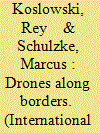

|
|
|
|
|
| Summary/Abstract |
This article examines the complex security landscape that is unfolding as states deploy military drones for border security and non-state actors with sharply diverging motives develop their own drone surveillance capacities. We argue that border security drones have contrary political, policy, and ethical implications. First, the encroachment of military technologies into non-military security operations may have adverse security repercussions, but drones may also save migrants’ lives as they make dangerous journeys through deserts and across rough seas. Second, drone surveillance erodes privacy but also creates new accountability mechanisms. Finally, drones may obviate some visible signs of security, such as fences, while also introducing an invisible security apparatus that extends beyond state boundaries. These contradictory effects help to explain the complex policy formation processes underlying drone border security programs in the United States and Europe, as well as the challenge of reaching clear answers about whether drone security is desirable.
|
|
|
|
|
|
|
|
|
|
|
|
|
|
|
|
| 20 |
ID:
157151
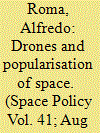

|
|
|
|
|
| Summary/Abstract |
The article presents drones as new devices used for military and civil purposes. The brief analysis focuses on civil uses of drones and their possible interrelation with space infrastructures. Unfortunately, drones are often known as “killing machines” having in many cases hit innocent civilians in war theatres. However, they can be used to improve security of citizens, for natural disasters prevention, for borders surveillance and mass migration control.
The initial reaction of many people is normally induced by the fear of unknown as often happens for new technologies, especially if they come from the sky. Therefore, it is vitally important to create awareness of aerospace and outer space activities to create social acceptance for such activities. The article presents some actions that can be taken by the competent authorities to help a smooth introduction of drones into the market, including a website to keep a dialogue with the public, actions that can be taken also for any new space activity.
Finally, the article examines some economic aspects that can jeopardise the popularisation of space activities, including drones, and the key information that should be passed on the general public to show how the investments in space activities and infrastructures bring enormous advantages to our daily life, promoting in such a way the popularisation of space.
|
|
|
|
|
|
|
|
|
|
|
|
|
|
|
|
|
|
|
|
|